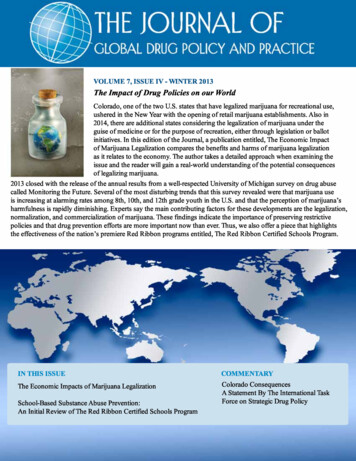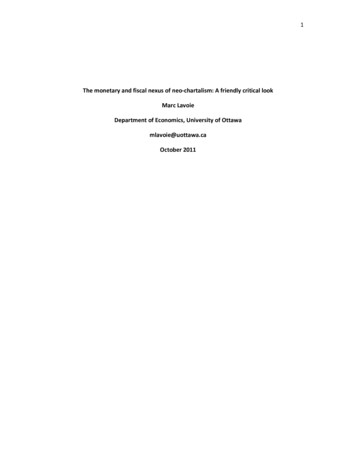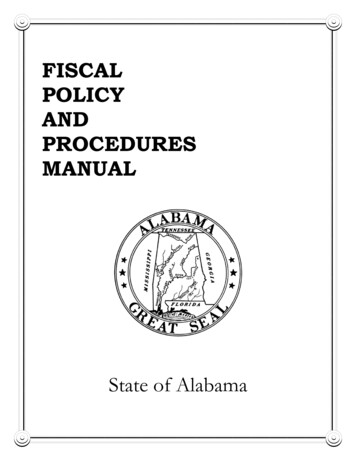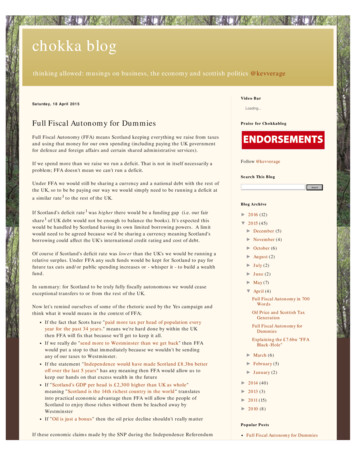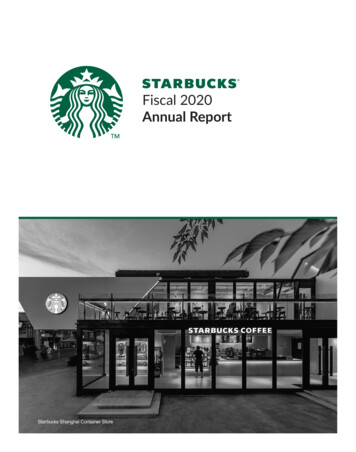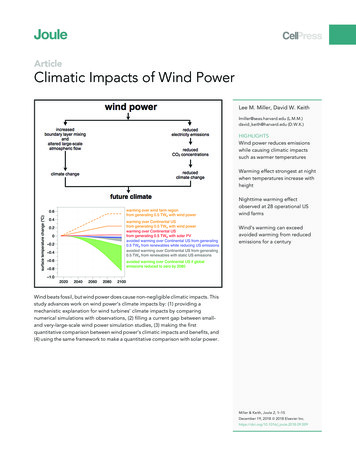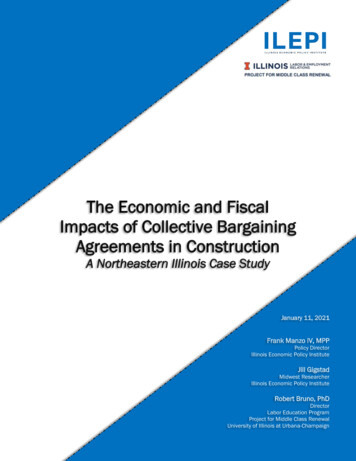
Transcription
fThe Economic and FiscalImpacts of Collective BargainingAgreements in ConstructionA Northeastern Illinois Case StudyJanuary 11, 2021Frank Manzo IV, MPPPolicy DirectorIllinois Economic Policy InstituteJill GigstadMidwest ResearcherIllinois Economic Policy InstituteRobert Bruno, PhDDirectorLabor Education ProgramProject for Middle Class RenewalUniversity of Illinois at Urbana-Champaign
THE ECONOMIC AND FISCAL IMPACTS OF COLLECTIVE BARGAINING AGREEMENTS IN CONSTRUCTION: A NORTHEASTERN ILLINOIS CASE STUDYExecutive SummaryFollowing the severe economic recession caused by the COVID-19 pandemic, Illinois is in urgent need of good jobsthat provide family-supporting incomes and ensure access to quality health care coverage. One essential industrythat has consistently offered pathways into good, middle-class careers is construction– primarily because it ishighly unionized with strong collective bargaining agreements (CBAs).A case study of CBAs between an association of union contractors and eight construction trades in the Chicagometro area reveals that construction industry CBAs provide workers ladders into the middle class. The typical union journeyworker earns 77,300 per year, on par with the average annual income for fulltime workers with bachelor’s degrees in Illinois’ urban areas ( 79,000 per year). On average, wages increased by 11 percent over the first three years of the CBAs, which is faster thaninflation (6 percent) and indicates that construction workers are better off now than three years ago. Union construction workers earn between 10 and 15 in health insurance benefits per hour worked.Construction industry CBAs fund the largest privately financed system of higher education in Illinois. Joint labor-management apprenticeship programs account for 97 percent of all construction apprentices. Joint labor-management apprenticeship programs have a 54 percent completion rate, significantly higherthan the 31 percent completion rate of employer-only programs. The eight joint labor-management apprenticeship programs in the Chicago metro area case study investat least 69 million per year training the next generation of skilled construction workers.Construction industry CBAs spur consumer spending, boost economic activity, and improve public budgets. CBAs supported 7.5 billion in total wages for 97,000 union construction workers in northeastern Illinoisin 2019. These middle-class construction workers spend money in the Illinois economy, saving or creating anadditional 49,000 jobs per year– particularly in hospitals, retail stores, and food service. Combined, construction industry CBAs in the Chicago area support more than 1.6 billion in total stateincome tax revenues, state sales tax revenues, and local property tax revenues each year.Statewide data released by the U.S. Department of Labor from 2010 through 2019 shows that constructionunionization promotes a strong middle class and reduces poverty in Illinois’ construction industry. The homeownership rate is 76 percent for households with union construction workers compared with73 percent for households with nonunion construction workers. The marriage rate is 63 percent for union construction workers compared with 57 percent for nonunionconstruction workers. The private health insurance coverage rate is 98 percent for union construction workers compared with70 percent for nonunion construction workers. Only 3 percent of union construction workers receive Earned Income Tax Credit (EITC) governmentassistance compared with 12 percent for nonunion construction workers.Without construction industry CBAs, there would be negative consequences for economic, fiscal, and socialoutcomes in northeastern Illinois. If skilled construction workers suddenly worked without CBAs: Economic activity would decrease by 2.2 billion annually and employment would shrink by 13,000 jobs. The State of Illinois would lose 315 million in combined income tax and sales tax revenues and localgovernments would lose 251 million in property tax revenues. More than 27,000 construction workers would lose their private health insurance coverage and more than8,000 construction workers would qualify for Earned Income Tax Credit (EITC) government assistance.Illinois’ construction industry offers a roadmap for family-sustaining careers in the post-COVID-19 economy. Thisessential industry demonstrates that both a robust middle class and a strong economy are outcomes produced byeffective collective bargaining agreements.i
THE ECONOMIC AND FISCAL IMPACTS OF COLLECTIVE BARGAINING AGREEMENTS IN CONSTRUCTION: A NORTHEASTERN ILLINOIS CASE STUDYTable of ContentsExecutive SummaryiTable of ContentsiiAbout the AuthorsiiIntroduction1Economic Research on Collective Bargaining Agreements (CBAs)1CBAs Increase Construction Worker Earnings2CBAs Fund Illinois’ Largest Privately Financed System of Higher Education5CBAs Spur Consumer Spending, Boost the Economy, and Improve Public Budgets7CBAs Promote a Strong Middle Class and Reduce Poverty in Construction10The Impacts of Construction CBAs Compared with the Alternative: Ten Outcomes12Conclusion13Sources14About the AuthorsFrank Manzo IV, MPP is the Policy Director of the Illinois Economic Policy Institute. He earned a Master ofPublic Policy from the University of Chicago Harris School of Public Policy and a Bachelor of Arts in Economicsand Political Science from the University of Illinois at Urbana-Champaign.Jill Gigstad is the Midwest Researcher at the Illinois Economic Policy Institute. She earned a Bachelor of Artsin Political Science and International Studies from Iowa State University.Robert Bruno, PhD is a Professor at the University of Illinois at Urbana-Champaign School of Labor andEmployment Relations and is the Director of the Project for Middle Class Renewal. He earned a Doctor ofPhilosophy in Political Theory from New York University, a Master of Arts from Bowling Green StateUniversity, and a Bachelor of Arts from Ohio University.ii
THE ECONOMIC AND FISCAL IMPACTS OF COLLECTIVE BARGAINING AGREEMENTS IN CONSTRUCTION: A NORTHEASTERN ILLINOIS CASE STUDYIntroductionIllinois is in urgent need of good jobs. The novel coronavirus disease (COVID-19) has revealed the structuraleconomic inequities in Illinois, with essential workers and those in “face-to-face” sectors most at risk of beingexposed to the virus also earning lower wages, suffering from the highest job volatility, and having the highestlikelihoods of losing their employer-sponsored health insurance (Manzo & Bruno, 2020a). The pandemic has alsooccurred on the heels of rising inequality, with the inflation-adjusted incomes of the top 1 percent in Illinoisgrowing by 35 percent since 2000 compared with a 3 percent drop in annual income for the median household(Bruno & Manzo, 2019). Recovering from the severe economic recession caused by the public health emergencywill require rapid growth in good jobs that not only provide family-supporting incomes, but also ensure accessto quality health care coverage, paid family and medical leave policies, and retirement plans that allow workersto retire with dignity.One essential industry that has consistently offered pathways into good, middle-class jobs is construction. Thereare about 232,000 wage and salary employees in Illinois’ construction industry, including more than 187,000blue-collar construction and extraction workers (BEA, 2019; BLS, 2019a). In 2019, the construction industrycontributed 30.9 billion towards Illinois’ gross domestic product (GDP), which equates to a high annualproductivity level of 133,200 per construction worker (BEA, 2019).The primary reason why Illinois’ construction industry delivers good middle-class jobs is because it is highlyunionized with strong collective bargaining agreements. Nearly half of all workers in construction and extractionoccupations (46 percent) are union members in Illinois, a unionization rate that is nearly three times higher thanthe comparable U.S. average (17 percent) (Manzo et al., 2020). On average, union members earn 11 percenthigher wages than nonunion workers in Illinois (Manzo et al., 2020).Illinois’ unionized construction industry finances the vast majority of apprenticeship training for the nextgeneration of skilled construction workers. Between 2000 and 2016, joint labor-management apprenticeshipprograms that are cooperatively administered by labor unions and signatory employers trained 97 percent of allconstruction apprentices in Illinois. By requiring more hours of classroom and on-the-job training than publicuniversities, these joint labor-management apprenticeship programs deliver competitive earnings that rival thesalaries of workers with four-year bachelor’s degrees (Manzo & Bruno, 2020b).This report, authored jointly by the Illinois Economic Policy Institute (ILEPI) and the Project for Middle ClassRenewal (PMCR) at the University of Illinois at Urbana-Champaign, examines the economic, social, and fiscalimpacts of collective bargaining agreements (CBAs) in northeastern Illinois’ construction industry. Using a casestudy approach, the report evaluates the impact of building trades contracts in the Chicago metropolitan areaon worker earnings and apprenticeship training investments before a subsequent section assesses their effectson economic activity and state and local tax revenues. Then, individual-level data for construction workers acrossIllinois are analyzed to understand how construction unions affect Illinois’ middle class and social insuranceprograms. A subsequent section assesses impacts compared to an alternative scenario if skilled constructionworkers suddenly worked without collective bargaining agreements. A concluding section recaps key findings.Economic Research on Collective Bargaining Agreements (CBAs)Collective bargaining is the freedom of workers to join together in unions and negotiate contracts with theiremployers to establish the terms and conditions of employment. Collective bargaining is a method forformalizing labor-management relations, with workplace decisions made jointly by employers and employees,rather than unilaterally by one party. This process fosters democratic workplaces, with workers having a voice1
THE ECONOMIC AND FISCAL IMPACTS OF COLLECTIVE BARGAINING AGREEMENTS IN CONSTRUCTION: A NORTHEASTERN ILLINOIS CASE STUDYin decisions over working conditions and having the ability to elect representatives to bargain on their behalf.Collective bargaining agreements (CBAs) typically include terms on pay, hours, time off, health insurancebenefits, retirement benefits, safety procedures, and other workplace policies.Collective bargaining is protected in the United States by constitutional law. In 1935, the National Labor RelationsAct (NLRA) was passed, granting collective bargaining rights and organizing rights in the private sector (NLRB,2020). However, in the 85 years since NLRA was enacted, those rights have become increasingly inaccessible tothe overwhelming majority of the United States’ workforce. Following the Janus v. AFSCME Council 31 SupremeCourt case which was decided by a vote of 5-4 in June 2018, public sector workers are now allowed to receiveall the benefits of collective bargaining– including higher wages, better health care coverage, and legalrepresentation– without any requirement to pay for these services.Every year, millions of American workers across many sectors negotiate or renegotiate their workplacecontracts. Numerous studies have found that collective bargaining boosts wages for workers, specifically for lowincome employees, for middle-class workers, and for people of color (Callaway & Collins, 2017; Long, 2013;Mishel & Walters, 2003). On average, union households earn between 10 percent and 20 percent more thannonunion households– an income premium that has been consistent since the 1930s (Farber et al., 2018). InIllinois, for every 1 paid in union dues, more than 6 is returned to union members in after-tax income eachyear, a return on investment that is unparalleled for working families (Manzo & Bruno, 2016). Conversely, arecent study of three Midwest states with so-called “right-to-work” laws– which effectively weaken collectivebargaining rights– found that the average worker in those states earned 8 percent lower wages and the medianworker earned 6 percent less per hour than in states with free collective bargaining laws (Manzo & Bruno, 2017).Workers covered by collective bargaining agreements also have better fringe benefits. 95 percent of unionworkers have access to health care coverage, 94 percent have access to retirement plans, and 91 percent haveaccess to paid sick leave compared with just 68 percent health care access, 67 percent retirement plan access,and 73 percent paid sick leave access for nonunion workers (BLS, 2019b). Likewise, unions reduce poverty, lowerworker turnover, and fight against inequality and discrimination in ways that reduce taxpayer costs forgovernment assistance programs and increase tax revenues (Nunn et al., 2019; Manzo, 2015). According torecent economic research, union members contribute approximately 1,110 more in taxes and receive about 180 less in social safety net benefits, on average, than nonunion workers– positively impacting public budgetsby 1,290 per member per year (Sojourner & Pacas, 2018).Unions in the construction industry are no different. While unionization has declined over time for constructionworkers, the construction industry remains one of the most unionized private-sector industries in the nation,and Illinois’ construction workers are more unionized than their counterparts nationwide (CPWR, 2017; Manzoet al., 2020). Union journeyworkers in Illinois’ construction industry earn nearly 17 more per hour than theirnonunion counterparts (Manzo & Bruno, 2020b). This higher pay is in addition to better health and retirementbenefits, enhanced workplace safety procedures, and “gold standard” apprenticeship programs that ensure thenext generation of workers is trained and highly productive.CBAs Increase Construction Worker EarningsThis report reviews and analyzes collective bargaining agreements between the Mid-America RegionalBargaining Association (MARBA), a multi-employer association of union contractors, and eight constructiontrades unions in the Chicago metropolitan area. The following eight labor unions are included in the analysis:the International Association of Machinists and Aerospace Workers Mechanics’ Local 701, the InternationalUnion of Bricklayers and Allied Craftworkers District Council 1, the International Brotherhood of Teamsters Joint2
THE ECONOMIC AND FISCAL IMPACTS OF COLLECTIVE BARGAINING AGREEMENTS IN CONSTRUCTION: A NORTHEASTERN ILLINOIS CASE STUDYCouncil 25, the United Brotherhood of Carpenters and Joiners of America Chicago Regional Council ofCarpenters, the Operative Plasterers’ and Cement Masons’ International Association Local 11, the InternationalUnion of Operating Engineers Local 150, the Chicago Journeymen Plumbers Local Union 130 United AssociationInternational Union, and the Laborers International Union of North America Chicago Laborers’ District Council.In total, these unions represent about 195,000 members and their families, including retirees. For each trade,the most recent CBAs all span three to five years and range from 2017-2020 to 2020-2025.FIGURE 1: DATA ON CONSTRUCTION TRADES UNIONS, CBA YEARS, AND TOTAL MEMBERSHIP IN 2019UnionLength of Contract Effective Date Members in 2019Automobile Mechanics Local 7012018-20216/1/20188,938Bricklayers District Council No 12017-20206/1/20176,583Teamsters Joint Council No. 252019-20236/1/2019100,589Chicago Regional Carpenters2019-20246/1/201930,190Cement Masons Union 112017-20216/1/2017916Operating Engineers Local 1502017-20216/1/201722,500Chicago Journeymen Plumbers Local 1302020-20256/1/20206,164Laborers' District Council2017-20216/1/201718,767Total for All Eight Unions--194,647Source(s): Authors’ analysis of Mid-America Regional Bargaining Association CBAs (MARBA, 2020) and LM-2 union reports from the U.S.Department of Labor (USDOL, 2020).Collective bargaining agreements provide ladders into the middle class for skilled construction trades workersin Illinois (Figure 2). The typical union journeyworker in these eight trades earned about 44 per hour in 2019.The hourly base wage ranged from 39 per hour for the Teamsters Council 25, to 53 per hour for the OperatingEngineers Local 150. However, construction is a seasonal industry, with peak employment during the summermonths and little to no activity during the winter months. As a result, blue-collar construction workers in Illinoisonly work an average of 1,767 total hours every year, according to the most recent Economic Census ofConstruction (Census, 2017).FIGURE 2: HOURLY WAGE AND ANNUAL INCOME FOR JOURNEYWORKERS IN NORTHEASTERN ILLINOIS, BY TRADE, IN 2019Annual Income Average HourlyUnionfrom WagesBase WageAutomobile Mechanics Local 701 77,501 43.86Bricklayers District Council No 1 88,191 49.91Teamsters Joint Council No. 25 69,531 39.35Chicago Regional Carpenters 83,667 47.35Cement Masons Union 11 80,204 45.39Operating Engineers Local 150 94,446 53.45Chicago Journeymen Plumbers Local 130 86,936 49.20Laborers' District Council 80,840 45.75Weighted Average for All Eight Unions 77,293 43.74Source(s): Authors’ analysis of Mid-America Regional Bargaining Association CBAs (MARBA, 2020) and average hours worked by allconstruction workers in Illinois according to the Economic Census of Construction (Census, 2017).Using this average annual employment duration, the typical union journeyworker in northeastern Illinois earnsabout 77,300 in total wages per year. This is a solidly middle-class income that is on par with the average annualincomes for full-time workers with bachelor’s degrees in Illinois’ urban areas ( 79,000 per year), but less thanaverage earnings for similar workers with advanced degrees ( 112,000 per year), such as Master of BusinessAdministration (M.B.A), Doctor of Philosophy (Ph.D.), and Juris Doctor (J.D.) degrees (Figure 3). On average,3
THE ECONOMIC AND FISCAL IMPACTS OF COLLECTIVE BARGAINING AGREEMENTS IN CONSTRUCTION: A NORTHEASTERN ILLINOIS CASE STUDYunion journeyworkers complete about 7,300 hours of on-the-job and classroom training in Illinois’ joint labormanagement apprenticeship programs, 27 percent more than the minimum requirements to earn a bachelor’sdegree at Illinois’ public four-year universities (about 5,800 hours) (Manzo & Bruno, 2020b).FIGURE 3: EARNINGS FOR JOURNEYWORKERS VS. FULL-TIME WORKERS BY EDUCATION LEVEL IN URBAN ILLINOIS, 2018Annual Earnings for Full-Time Workers in Urban Areas in Illinois 120,000 112,026 100,000 80,000 79,007 77,293 53,463 60,000 45,113 40,000 20,000 0Workers with Masters,Workers withUnion JourneyworkerWorkers withWorkers with HighProfessional, andBachelor’s Degrees in Northeastern Illinois Associate’s Degrees School Degrees (2018)Doctorate Degrees(2019)(2018)(2018)(2018)Source(s): Authors’ analysis of Mid-America Regional Bargaining Association CBAs (MARBA, 2020), average hours worked by allconstruction workers in Illinois according to the Economic Census of Construction (Census, 2017), and data from the 2018 AmericanCommunity Survey (five-year estimates) on workers who report that they usually work 35 or more hours per week in urban areas in Illinois(Ruggles et al., 2020).Over their most recent collective bargaining agreements, construction workers in northeastern Illinois are betteroff now than they were just a few years ago (Figure 4). In the eight trades with contracts negotiated with MARBAcontractors, the hourly base wage increased by between about 1 per hour for the Automobile Mechanics’ Local701 and nearly 3 per hour for the Operating Engineers Local 150 in the first three years. On average, hourlywages increased by 2 per year for union construction workers in the local labor market, or a compoundedchange of 11 percent over three years. This annual wage gain exceeded the 6 percent compounded increase inconsumer prices between July 2017 and July 2020 (BLS, 2020) (Figure 5). With wages rising faster than inflation,CBAs have strengthened the middle-class status of construction workers in the Chicago metro area.FIGURE 4: INCREASE IN HOURLY WAGE IN NORTHEASTERN ILLINOIS, BY TRADE, FIRST THREE YEARS OF CONTRACTWage Increases by YearUnionYear 1 Year 2 Year 3 AverageAutomobile Mechanics Local 701 1.15 1.15 1.25 1.18Bricklayers District Council No 1 2.23 2.30 0.00 1.50Teamsters Joint Council No. 25 1.94 2.00 2.07 2.00Chicago Regional Carpenters 1.20 1.21 1.24 1.22Cement Masons Union 11 2.24 2.30 2.37 2.30Operating Engineers Local 150 2.80 2.90 3.00 2.90Chicago Journeymen Plumbers Local 130 1.94 2.19 2.66 2.27Laborers' District Council 2.24 2.31 2.39 2.32Weighted Average for All Eight Unions 1.92 1.99 1.99 1.97Source(s): Authors’ analysis of Mid-America Regional Bargaining Association CBAs (MARBA, 2020).4
THE ECONOMIC AND FISCAL IMPACTS OF COLLECTIVE BARGAINING AGREEMENTS IN CONSTRUCTION: A NORTHEASTERN ILLINOIS CASE STUDYConstruction industry collective bargaining agreements in northeastern Illinois also ensure that constructionworkers have access to both high-quality health insurance and retirement plans (Figure 6). In the Chicago metroarea, union construction workers earn between 10 and 15 in health insurance benefits per hour worked.Union construction workers also invest about 10 to 13 in pension contributions per hour worked.Consequently, while the minimum wage is currently 13.50 per hour in the City of Chicago and 10 per hour inthe rest of Illinois, union construction workers in northeastern Illinois earn more than twice those amounts incombined health insurance and retirement benefits alone per hour due to their CBAs. Union constructionworkers in the Chicago metro area earn between 20 and 27 per hour in these fringe benefits (Figure 6). Bypromoting financial security through middle-class wages and strong fringe benefits, collective bargainingagreements attract and retain skilled workers into the trades in the Chicago metro area.FIGURE 5: AVERAGE INCREASE IN CONSTRUCTION WORKER WAGES IN NORTHEASTERN ILLINOIS VS. INFLATION, 2017-2020Percent Wage Increases vs. Annual InflationUnionYear 1 Year 2 Year 3 CompoundedWeighted Average for All Eight Unions3.67%3.66%3.53%11.26%Inflation: CPI-U (July 2017- July 2020)2.95%1.81%0.99%5.85%Source(s): Authors’ analysis of Mid-America Regional Bargaining Association (MARBA, 2020) CBAs and the national rise in the averagecost of living between July 2017 and July 2020 according to the Consumer Price Index for All Urban Consumers (CPI-U) (BLS, 2020).FIGURE 6: HEALTH AND RETIREMENT BENEFITS, HOURLY, FOR UNIONS WITH HOURLY CONTRIBUTIONS, 2019Health & Welfare and Pension Fund Contribution Per Hour 15.05 16.00 14.00 12.00 10.00 14.65 12.05 10.45 9.60 13.00 12.32 11.58 10.00 9.75 8.00 6.00 4.00 2.00 0.00Bricklayers District Cement Masons Union Operating EngineersCouncil No 111Local 150Health & Welfare ContributionTechnical PlumbersEngineers Local 130Laborers' DistrictCouncilPension Fund ContributionSource(s): Authors’ analysis of Mid-America Regional Bargaining Association CBAs (MARBA, 2020).CBAs Fund Illinois’ Largest Privately Financed System of Higher EducationRegistered apprenticeships are training programs in which participants get the opportunity to “earn while theylearn,” with tuition costs covered by employers and labor-management organizations who gain access to a poolof skilled and productive workers for physically demanding and often hazardous occupations. Apprenticeshiptraining is particularly important to the construction industry in Illinois. With contractors in need of skilled labor,these programs ensure a stable supply of workers for high demand occupations. Since 2000, 85 percent of allregistered apprentices in Illinois were enrolled in construction training programs (Manzo & Bruno, 2020b).5
THE ECONOMIC AND FISCAL IMPACTS OF COLLECTIVE BARGAINING AGREEMENTS IN CONSTRUCTION: A NORTHEASTERN ILLINOIS CASE STUDYApprenticeship programs are sponsored either jointly by labor unions and signatory employers or unilaterally byemployers. The largest apprenticeship programs in the state are the joint labor-management programs, whichare cooperatively administered and have standards and wages that are privately negotiated betweencontractors and unions. These programs are funded by “cents-per-hour” contributions from employers. Bycontrast, employer-only programs rely entirely on voluntary contributions from contractors. These programs areoften smaller and poorly funded because contractors struggling to win short-term project bids have lessincentive to invest in long-term workforce training. As a result, joint labor-management apprenticeshipprograms account for 97 percent of all construction apprentices in Illinois. Joint labor-management programsare also more diverse apprenticeship classes than employer-only programs (Manzo & Bruno, 2020b).Through collective bargaining agreements, Illinois’ construction industry operates the largest privately financedsystem of higher education in the state (Figure 8). For the construction trades analyzed in this report, employersinvest between 0.40 per hour and 1.37 per hour in apprenticeship training on behalf of their workers. Theseper-hour contributions by union contractors and current construction workers provide substantial revenue totrain future construction workers. In the most recent fiscal years available, these eight registered apprenticeshipprograms invested at least 69 million over the year training the next generation of skilled construction workers,based on Form 990 tax data disclosed to the Internal Revenue Service (IRS) and made publicly available on onlinedatabases (ProPublica, 2020; Candid, 2020) (Figure 9).FIGURE 8: APPRENTICESHIP BENEFITS PER HOUR, FOR FIVE UNIONS WITH HOURLY CONTRIBUTIONS, 2019Training Fund Contriubtion Per Hour 1.60 1.30 1.40 1.37 1.20 1.00 0.80 0.60 0.40 0.50 0.50 0.40 0.20 0.00Bricklayers District Cement MasonsCouncil No 1Union 11OperatingTechnical Plumbers Laborers' DistrictEngineers LocalEngineers LocalCouncil150130Source(s): Authors’ analysis of Mid-America Regional Bargaining Association CBAs (MARBA, 2020).FIGURE 9: TOTAL EXPENSES OF REGISTERED APPRENTICESHIP PROGRAMS, FY2017 OR FY2018UnionTotal Apprenticeship InvestmentAutomobile Mechanics Local 701 680,880Bricklayers District Council No 1 2,416,492Teamsters Joint Council No. 25 1,044,117Chicago Regional Carpenters 16,004,614Cement Masons Union 11Not availableOperating Engineers Local 150 30,339,359Chicago Journeymen Plumbers Local 130 6,768,543Laborers' District Council 11,604,077Total for All Seven Unions 68,858,082Source(s): Authors’ analysis of IRS Form 990 reports (ProPublica, 2020; Candid, 2020) for most recent year available, either fiscal year2018 or fiscal year 2017.6
THE ECONOMIC AND FISCAL IMPACTS OF COLLECTIVE BARGAINING AGREEMENTS IN CONSTRUCTION: A NORTHEASTERN ILLINOIS CASE STUDYRegistered apprenticeships are the bachelor’s degrees of the construction industry and are a great alternativeto college for Illinois’ youth. In Illinois, the number of active apprentices has expanded by 44 percent since 2011(DOLETA, 2019). At the same time, total enrollment at Illinois’ public universities fell by 11 percent from Fall2011 to Fall 2018 (IBHE, 2019). In particular, joint labor-management apprenticeship programs negotiated inconstruction CBAs require an average of 7,300 hours of training and have a 54 percent completion rate. Theseoutcomes are significantly better than the comparable requirements (6,300 hours) and completion rate (31percent) for employer-only construction programs (Manzo & Bruno, 2020b). In fact, joint labor-managementapprenticeship programs in construction also deliver training hours, graduation rates, and competitive earningsthat rival the performance of Illinois’ four-year universities (Manzo & Bruno, 2020b).CBAs Spur Consumer Spending, Boost the Economy, and Improve Public BudgetsTo calculate the effect of construction industry CBAs on economic activity, this analysis utilizes IMPLAN. IMPLANis an industry-standard economic modeling software that inputs U.S. Census Bureau data, accounts for theinterrelationship between households and businesses, and follows dollars as they cycle throughout the economy(IMPLAN, 2020). Estimating the effect on consumer demand requires average annual incomes to be multipliedby the total number of current members actively employed in construction (Figure 10). The number of unionmembers reported in annual LM-2 reports submitted to the U.S. Department of Labor generally includes retireesas well as other working-age members who are not actively employed for any reason, including those who areunemployed or out-of-work due to illnesses or injuries. To determine the share of total members who areactively employed, Figure 10 compares available data on current workers reported in annual funding noticesthat are required by the unions’ pension plans (e.g., MOE, 2020). On average, current workers account for abouthalf (51 percent) of the total membership reported in fiscal year 2019 LM-2 reports. Notably, these unionconstruction workers participate in pension plans that have an average funded ratio of 84 percent, which is inthe “green zone” and not in critical or endangered status under federal pension law.FIGURE 10: CURRENT EMPLOYEES (FY2019 OR FY2018 NOTICE) VS. TOTAL MEMBERS (FY2019), AND FUNDED RATIOSCurrentReportedCurrentPensionUnionWorkers Members Worker Share Funded RatiosAutomobile Mechanics Local 701 (FY18)4,4499,27948.9%76.0%Chicago Regional Carpenters (FY18)11,82530,36339.0%93.0%Operating Engineers Local 150 (FY19)12,51122,50055.6%80.9%Laborers' District Council (FY18)12,14318,36166.1%83.1%Total or Weighted Average for Four Unions40,9288
workers suddenly worked without collective bargaining agreements. A concluding section recaps key findings. Economic Research on Collective Bargaining Agreements (CBAs) Collective bargaining is the freedom of workers to join together in unions and negotiate contracts with their employers to establish the terms and conditions of employment.



